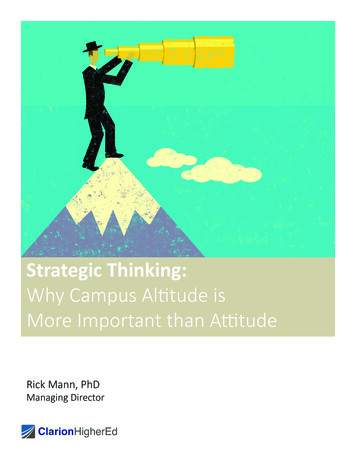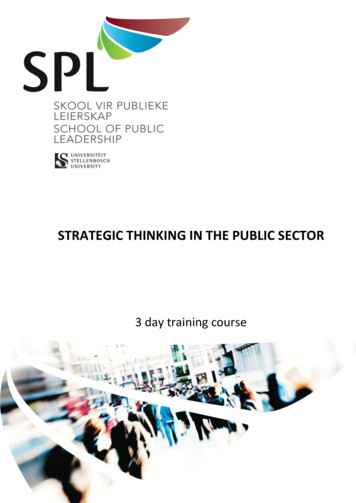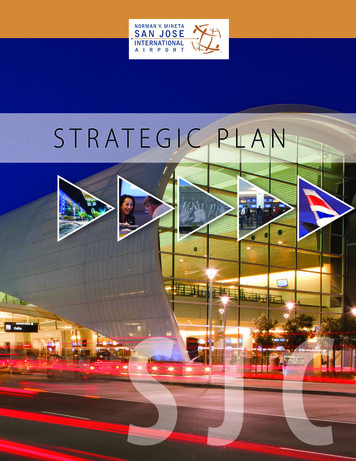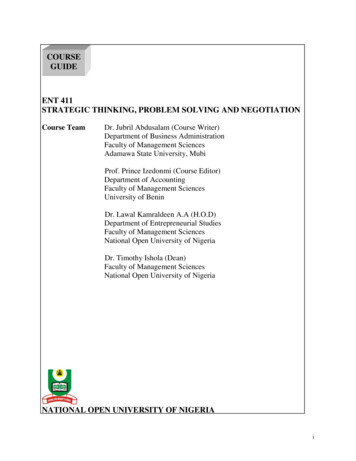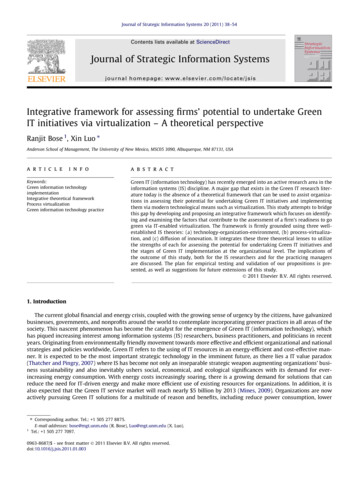
Transcription
Journal of Strategic Information Systems 20 (2011) 38–54Contents lists available at ScienceDirectJournal of Strategic Information Systemsjournal homepage: www.elsevier.com/locate/jsisIntegrative framework for assessing firms’ potential to undertake GreenIT initiatives via virtualization – A theoretical perspectiveRanjit Bose 1, Xin Luo Anderson School of Management, The University of New Mexico, MSC05 3090, Albuquerque, NM 87131, USAa r t i c l ei n f oKeywords:Green information technologyimplementationIntegrative theoretical frameworkProcess virtualizationGreen information technology practicea b s t r a c tGreen IT (information technology) has recently emerged into an active research area in theinformation systems (IS) discipline. A major gap that exists in the Green IT research literature today is the absence of a theoretical framework that can be used to assist organizations in assessing their potential for undertaking Green IT initiatives and implementingthem via modern technological means such as virtualization. This study attempts to bridgethis gap by developing and proposing an integrative framework which focuses on identifying and examining the factors that contribute to the assessment of a firm’s readiness to gogreen via IT-enabled virtualization. The framework is firmly grounded using three wellestablished IS theories: (a) technology-organization-environment, (b) process-virtualization, and (c) diffusion of innovation. It integrates these three theoretical lenses to utilizethe strengths of each for assessing the potential for undertaking Green IT initiatives andthe stages of Green IT implementation at the organizational level. The implications ofthe outcome of this study, both for the IS researchers and for the practicing managersare discussed. The plan for empirical testing and validation of our propositions is presented, as well as suggestions for future extensions of this study.Ó 2011 Elsevier B.V. All rights reserved.1. IntroductionThe current global financial and energy crisis, coupled with the growing sense of urgency by the citizens, have galvanizedbusinesses, governments, and nonprofits around the world to contemplate incorporating greener practices in all areas of thesociety. This nascent phenomenon has become the catalyst for the emergence of Green IT (information technology), whichhas piqued increasing interest among information systems (IS) researchers, business practitioners, and politicians in recentyears. Originating from environmentally friendly movement towards more effective and efficient organizational and nationalstrategies and policies worldwide, Green IT refers to the using of IT resources in an energy-efficient and cost-effective manner. It is expected to be the most important strategic technology in the imminent future, as there lies a IT value paradox(Thatcher and Pingry, 2007) where IS has become not only an inseparable strategic weapon augmenting organizations’ business sustainability and also inevitably ushers social, economical, and ecological significances with its demand for everincreasing energy consumption. With energy costs increasingly soaring, there is a growing demand for solutions that canreduce the need for IT-driven energy and make more efficient use of existing resources for organizations. In addition, it isalso expected that the Green IT service market will reach nearly 5 billion by 2013 (Mines, 2009). Organizations are nowactively pursuing Green IT solutions for a multitude of reason and benefits, including reduce power consumption, lower Corresponding author. Tel.: 1 505 277 8875.1E-mail addresses: bose@mgt.unm.edu (R. Bose), Luo@mgt.unm.edu (X. Luo).Tel.: 1 505 277 7097.0963-8687/ - see front matter Ó 2011 Elsevier B.V. All rights reserved.doi:10.1016/j.jsis.2011.01.003
R. Bose, X. Luo / Journal of Strategic Information Systems 20 (2011) 38–5439costs, lower carbon emissions and environmental impact, improved systems performance and use, increased collaborationand interaction amid constituents, space savings, and an agile workforce.Esty and Winston (2006) revealed how companies generate lasting value – cutting costs, reducing risks, increasing revenues, and creating strong brands – by building environmental thinking into their business strategies. They explored whatevery executive must know to manage the environmental challenges facing society and business. According to a 2009 GreenIT report surveying 426 companies in North America and a total of 1052 worldwide, 86% of companies stated that it is somewhat/significantly important that their IT organization implement Green IT initiatives. The report also found that 97% ofcompanies are at least discussing a Green IT strategy (Symantec, 2009). In addition, a recent CIO magazine survey of IT executives revealed that cost-cutting and social responsibilities are the two main factors driving Green IT initiatives (CIO, 2008).UN’s agenda 21 program, for sustainable development, provides a comprehensive blueprint of action to be taken globally,nationally, and locally by organizations of the United Nations, governments, and others to preserve the environment. In2009, the European Commission called on the IT industry to step up efforts to cut emission by 15% by 2020. Their new actionplan aims to establish common energy-efficiency metrics and industry-wide emission targets. At the same time, CIOs areconsidering how to best undertake Green IT initiatives, especially in time of shrinking IT budgets and increasing environmental compliance requirements in terms of ensuring socially responsible, environmentally friendly, and fiscally sound ITinvestments and practices. Given the above mentioned practical advantages for Green IT, many organizations are keen tounderstand how to accept and initialize Green IT schemes and further harness them toward competitive advantages (Estyand Winston, 2006; Velte et al., 2008; Watson et al., 2010). As such, there is a compelling and timely need to understandthe salient facilitators that are important for assessing organizations’ potential vis-à-vis possible Green IT approaches.The Green IT strategy, design, and practice initiatives within organizations have recently emerged into an active researcharea in the IS discipline. However, the extant Green IT literature is heavily based on case studies, anecdotes, and survey ofcurrent practices thus quite fragmented and scattered. A major gap that exists in the literature today is the absence of a theoretical framework that can be used to assist organizations in assessing their potential for undertaking Green IT initiativesand then implementing them via modern technological means such as virtualization. To advance this line of research, thisstudy attempts to bridge that gap by developing and proposing an integrative framework which focuses on identifying andexamining the factors that contribute to the assessment of a firm’s readiness to go green via IT-enabled virtualization. Thisstudy is targeted to both Green IT researchers and practitioners. The proposed framework is intended to provide a roadmapfor future Green IT research and development. The comprehensive review of the current Green IT literature and practice thatis provided herewith is intended to assist managers – who are currently or contemplating practicing Green IT in their organizations – by keeping them abreast with current practices and by helping them identify areas of practice where their organizations can have immediate impact on energy conservation.The paucity of scientific investigations in the literature limits our understanding of the process of virtualization forachieving Green IT. Most competitive organizations today are seeking to create a dynamic infrastructure that converge business and IT infrastructure to work in concert to achieve high levels of productivity and business value. At present, the keyfacilitator to building a dynamic infrastructure is the virtualization process. As an organizational design practice that resultsin flattened organizational structures, larger spans of control, and extensive geographically dispersed work, virtualizationallows IT to respond more quickly to changing business demands (Liu et al., 2008). Consolidating resources through virtualization increases the efficiency of organizational resource utilization. Advances in the technology, along with higher degrees of automation, offer more opportunities for consolidation than ever before. IT virtualization reduces costs forhardware, improves software testing and deployment, reduces energy and physical space use, and increases the flexibilityof hardware investments. Similarly, automation of business processes through virtualization (e.g., online electronic commerce) enables increased utilization of business resources, time and space flexibility for the participants and operationsof the process along with reduction in cost and improved service delivery to customers. As such, we posit that virtualizationis one of the possible means that today’s organizations can employ to respond to the requirement for ‘‘Reduce, Reuse, Recycle’’, the global green mantra (Velte et al., 2008). In this paper, we argue that virtualization is the primary force for organizations to integrate environmental sustainability into business and IT practices and therefore treat it as the underpinningof this study. One general research question drove this study: What framework can be used as a theoretical foundation forstudying Green IT across different stages?Our approach diverges from the majority of prior research because we posit that virtualization, which can provide most ofthe business drivers to make Green IT happen, needs to be holistically viewed and investigated. Drawing on the technologyorganization-environment (TOE) framework (Tornatzky and Fleischer, 1990) and the process-virtualization-theory (PVT)framework (Overby, 2008), this paper breaks new ground by presenting an integrative research model that incorporatesthese theoretical lenses to synergistically achieve the strengths of each for assessing the potential for undertaking GreenIT initiatives and the stages of Green IT implementation at the organizational level. Grounded in the innovation diffusionliterature (Fichman, 2000; Rogers, 1995), the model defines Green IT implementation as a series of stages from a firm’s initialevaluation of Green IT at the pre-adoption stage (i.e., initialization), to its formal adoption (i.e., integration), and finally to itsfull-scale deployment at the post-adoption stage in which Green IT becomes an integral part of a firm’s value chain activities(i.e., maturation).In an effort to contribute to the literature of Green IT, the model that we propose links technological, organizational, andenvironmental factors to the potential for undertaking Green IT initiatives. In essence, the main constructs and underlyingtheories of the PVT framework are applied to the technological factors to assess the virtualizability of the Green IT initiatives.
40R. Bose, X. Luo / Journal of Strategic Information Systems 20 (2011) 38–54In addition to extending previous research on Green IT, the study proposes that sensory readiness, relationship readiness,synchronism readiness, identification and control readiness, champion support, resource commitment, firm size, regulatorysupport and competition intensity are important antecedents of undertaking Green IT initiatives via virtualization. Based onthis research model a series of propositions are developed. We expect that the outcome of this study will provide businessmanagers with the knowledge and guidance regarding the development and implementation of Green IT initiatives in theirorganizations. Actions can be devised regarding appropriate management/leadership and technical approaches. In otherwords, the integrative theoretical framework presented in this study will help inform Green IT practice in organizations.At present, there is a dearth of empirical research in the area of Green IT. Additionally we expect that this study will helpthe IS research community: to empirically test and validate the propositions made in our research model, and to articulatea future research agenda for this emerging and important field.The rest of the paper is organized as follows. An overview of Green IT is provided in Section 2. The three frameworks –TOE, PVT, and Innovation Diffusion – are summarized in Section 3 to set up the theoretical foundation of our study. Section 4describes our proposed research model and the propositions based on this model. Section 5 discusses the implications of thisresearch from the perspectives of both: research and practice of Green IT. Methodological implications and validation approaches are also presented to set the stage for future research on Green IT to further refine and validate the framework.The concluding remarks are provided in Section 6 as well as the limitations of this research and plans for future research.2. Overview of Green ITIn the face of ever-increasing energy costs, researchers, practitioners, and governments are now seeking effectively initiatives to regulate inefficient energy use by global business enterprises. For example, the UK government aims at decreasinggreenhouse gas by 20% before 2020 (Capra and Merlo, 2009). IT now plays a crucially important role in the environmentaland energy issues related to Green IT, because Green IT may refer to three primary research areas: (1) energy efficiency of IT,(2) eco-compatible management of the lifecycle of IT, and (3) IT as an enabler of green governance (Capra and Merlo, 2009).In essence, IT enhances organizational efficiency via substitution for more costly labor and regular capital, and enables newprocesses and services (Chwelos et al., 2010). Having been conceptualized in several ways, Green IT, in general, focuses ondesigning, manufacturing, using and disposing of computer, servers and associated subsystems efficiently and effectivelywith minimal or no impact on the environment (Dedrick, 2010). Organizations today are conscientious about being ‘‘green,’’but they are not sure how to go about it. The emergence of Green IT as an important strategic issue has been triggered by therecognition that environmental sustainability, which was once little more than a moral incentive for companies, has nowbecome an imperative to doing business and hence an imperative for IT (Esty and Winston, 2006; Murugesan, 2008; Velteet al., 2008; Watson et al., 2010). Prior studies have stated that, via an input-production-output chain, IT capital is an elementin a production function through which inputs are transformed to outputs via a production process. As shown in Fig. 1, information systems can influence the greening process and the ability to sustain economic growth as IT capital is an input intothis process and is also the energy required to use IT.Consequently the breadth and depth of the knowledge on the greening process are steadily evolving and are beingincreasingly studied by organizations to help them develop their Green IT strategy. Due to this evolutionary stage of GreenIT, today being ‘‘green’’ means different things to different organizations – that is, there is still a lack of a universal understanding (Velte et al., 2008). Organization, by definition, is a collective, with individuals and larger units in different rolesthat involve different perspectives and values (March and Simon, 1993). Furthermore, the literature of organizational learning has suggested that, in regard to the different perceptions of greenness, learning-curve heterogeneity across organizationsin terms of learning rates, industry environment, direction (i.e., dimension) as well as goal orientation influences the direction of learning (Balasubramanian and Lieberman, 2010). Their explanation of the meaning of being ‘‘green’’ depends on theirpreference for the path ranging from e-waste management to electrical power control they would like to pursue. Thus, forsome organizations, it might mean buying technology that is more energy-efficient than what they have. Whereas othersmight suggest that it is an issue of reducing the amount of electricity their datacenter consumes. For some others, it mightmean buying hardware that is made of environmentally friendly components. Yet for others they might look at the end ofhardware life and suggest that Green IT means proper disposal of them. Green IT is definitely a combination of all of theGovernment PolicyIndividual BehaviorIT CapitalInputsIT-enabled Changes inManagement PracticesDemand PatternsAdded Business ValueProduction ProcessFig. 1. Green IT process (adapted from (Dedrick, 2010)).Output
R. Bose, X. Luo / Journal of Strategic Information Systems 20 (2011) 38–5441Table 1Opportunities and challenges of Green IT (Source: Molla et al., 2009).Opportunities/drivers of Green ITChallenges/barriers of Green ITReducing cost of IT (80%)Corporate strategy (79%)Environmental consideration (77%)Social acceptance (71%)Maturity of Green IT industry (64%)Government regulations (57%)Government incentives (54%)Clients’/consumers’ pressure (48%)Industry associations (29%)Competitors’ actions (20%)IT vendors’ pressure (14%)Green IT uptake by more organizations (46%)Cost of Green IT solutions (71%)Unclear business value of greening IT (48%)Lack of government incentives (44%)Lack of business leadership on Green IT (43%)The extent of IT sophistication (41%)Inadequate skills and training (36%)The extent of Green IT adoption in the industry (34%)Absence of enforceable government regulations (33%)aforementioned issues and beyond. Nevertheless, each of the above organizations, irrespective of their conceptualization ofwhat being ‘‘green’’ means, is making positive contributions to themselves and to the environment.The current literature on Green IT research and practice suggest that there exist factors beyond the control of IT whichhelp create a sense of urgency in Green IT. Businesses are increasingly beginning to comprehend that ‘‘greening’’ is possiblewhile making a solid return on the investment. The three primary drivers of Green IT initiatives according to the literatureare: (1) reducing costs due to budget cuts, (2) reducing consumption due to resource restrictions, and (3) complying with thelocal law. Additionally, a study based on a survey of 143 organizations from USA, Australia, and New Zealand (Molla et al.,2009b) reported the current drivers and inhibitors of Green IT adoption, which are summarized in Table 1. The number inside the parentheses represents the percentage of respondents who agree.In extant IS literature, the heightened importance of ecological sustainability has generated an array of research on GreenIT/IS (Watson et al., 2010). As such, a number of methodological approaches have been devoted to understanding: (1) conceptualization of Greenness (Ijab et al., 2010), (2) the intersection of environmental responsibility and global IT outsourcing(Babin and Nicholson, 2009), (3) organizational adoption of Green IS and IT, (4) develop and justify energy conservation measures for Green IT (Corbett et al., 2010), (5) identify a set of software complexity and quality metrics that can be used to estimate energy consumption and to compare specific software applications (Capra and Merlo, 2009), and (6) define andmeasure green-readiness (Molla et al., 2009a). There is now a consensus about the direct and negative effects of the IT industry and the IT artifacts on the environment. In essence, such theories as transaction cost theory, institutional theory, andorganizational-capability-based theory have already been employed to explain why one type of organizational structure(i.e., go green) is adopted over others. Transaction cost theory posits that organizations decide on a specific governance structure based on its ability to economize on the cost of doing business. As such, reduced cost is a major factor in adopting virtualwork environment by managerial decision-makers (Liu et al., 2008). As a complementary explanation to transaction cost theory, organizational-capability-based theory holds that the capabilities of an organization define its boundaries and structure(Ghoshal and Morgan, 1996). It has been found that novel structures are adopted by the organization when they help theorganization utilize its capabilities to realize business value. Therefore, such innovation as virtualization may aid in implementing capabilities accessible to potential adopters. In addition, institutional theory provides a useful theoretical lens tostudy the organizational response to environmental issues from mimetic pressures, mimetic coercive, and coercive pressures. It posits that organizations are subject to external influences, such as institutional pressures and promotion, whichcause them to become homogeneous. IS studies have recognized the significance of institutional forces as important predictors of the adoption and diffusion of IS products and practices (Chen et al., 2009; Liang et al., 2007).In recent years the concept of process virtualization has been playing a major role in designing and implementing a dynamic business environment. The capabilities and availability of the virtualization technologies and the current economicclimate are the main drivers toward this movement. Process virtualization includes both the virtualization of the IT infrastructure of an organization as well as the virtualization of its business processes. It is conceptualized as the applicationof intelligent, network-enabled (Applegate, 2003), automation within and across the organizational boundaries to leverageits people, capital, technology, and knowledge resources to achieve significant improvements in productivity, value, andcompetitiveness. Examples include e-business capabilities from business process point of view as well as server virtualization in the datacenters from IT infrastructure point of view.Despite the fact that a downside to virtualization is that its complexity requires frequent maintenance and support tools(Ruth, 2009), process virtualization is the main driver of Green IT implementation in organizations building environmentalthinking into their business strategies (Harris, 2008). While virtualization ushers complexity and difficulty for systemadministrators to visualize and the problems may persist before the proper tools are employed, the downside risks are overwhelmed by the benefits. In general, the primary reasons being: (1) virtualization helps consolidate resources – both ITbased and non-IT-based resources – which help increase the efficiency of organizational resource utilization; and (2) virtualization adds flexibility in terms of time and space to efficiently conduct business processes which help contribute to costsavings and to improving the overall process effectiveness. Process virtualization’s aim is to improve efficiency and reduce
42R. Bose, X. Luo / Journal of Strategic Information Systems 20 (2011) 38–54overhead. We envision that the application of powerful computer platforms, combined with enabling software and highcapacity networks, to provide the fabric with which the virtual business infrastructure for Green IT initiative implementationwill be created. Thus, process virtualization would involve the application of these technologies in the context of a singleindividual, a team, a department, a business unit or the entire company to improve efficiency and reduce overhead. Froma managerial perspective, virtualization increases IT’s agility because managers can help their organizations convert shortertime to market into market share and top-line revenue growth (Willoughby, 2010). For an organizational end-user, a purpose-built or on-demand application can be dynamically delivered to any end-user device with the settings and services required by the individual user. Thus, this process of decoupling all key components of the user environment from theunderlying system may significantly simplify system control and management in terms of network configuration and policyspecification. For the aforementioned reasons we contend that process virtualization is the primary force for organizations tointegrate and implement environmental sustainability into their business and IT practices.The current literature on Green IT research and practice additionally suggest that businesses can become involved inshaping Green IT policies and reducing their organization’s carbon footprint in three critical areas: (1) asset management,(2) energy efficiency, and (3) enabling green practices through the utilization of IT (Murugesan, 2008; Schreck and Dines,2009). Asset management includes the design, procurement, operations, and end-of-life management of IT equipments orproducts with the goal to reduce the burdens that these products have on the environment (McKinsey, 2009). IT productshave a significant impact on the environment. They contain chemicals known to be threat to human health and the environment – lead, mercury, cadmium and brominated flame retardants among them. They create e-waste at the end of theirlifecycle.Achieving the highest return on IT assets is a balancing act. Asset managers have to find an optimal solution juggling fourkey variables/constraints: (a) achieving highest levels of reliability, (b) at the lowest cost, (c) within a compliance framework,and (d) with limited resource. Asset management thus aims to maximize the value of critical assets over their lifecycle. Optimizing the energy efficiency of the business and IT infrastructure is critical to demonstrate the value of green. The optimization functions to be used are firm-specific and are determined based on their IT readiness and infrastructure. Desktop andenterprise computer equipment require significant energy to operate, leading to increased greenhouse gas emissions. Today,large consolidated data centers alone use more than 5% of all electricity consumed in the United States. The Green Grid, anindustry consortium dedicated to improving energy efficiency within data centers and business computing systems, isresponsible for defining and promoting the most effective energy efficiency practices in data center operations, constructionand design in order to help solve the problems related to power consumption, power conversion and energy efficiency thatare plaguing data centers worldwide. Energy efficient IT infrastructures can consequently reduce costs, resolve space, powerand cooling constraints that impact growth, improve flexibility and responsiveness, and achieve Green strategy objectives.Many businesses are considering a new computing paradigm, called cloud computing, to optimize utilization and minimize cost of their IT infrastructure. Referring to both the applications delivered as services over the Internet and the hardware and systems software in the data centers that provide those services, cloud computing leverages shared infrastructureto deploy and balance IT resources to cater to the computing needs in real-time (Armbrust et al., 2010). As a catalyst for creating a paradigm shift and a wave of innovation and change in the globe (Greengard, 2010), cloud computing can help organizations of all sizes go green by providing a shared and on-demand infrastructure with virtualization capabilities (Durkee,2010; Vouk, 2008). Thus, organizations can access services and infrastructure on an as-needed basis, and promote the abilityto maintain distributed workforces. Virtualization is an energy-efficient consolidation technology found in cloud computingcenters today. Virtualization helps reduce energy consumption and costs by increasing utilization and decreasing the number of servers and physical floor space in the data center (Kumar and Mieritz, 2007). It has been reported that virtualizationhas been shown to reduce floor space by 80% and energy consumption in data centers by 40%.To address the corporate commuting and office space issues, and to offer flexibilities to both employees and employers,Telework has become an important contributor to green practices (Ruth, 2009), as companies such as IBM, Sun Microsystems, and Cisco have been using telecommuting for half their workforce for more than a decade. This environmentallyfriendly practice provides a multitude of benefits that include increased productivity, lower cost due to reduction in officespace requirement, reduced business travel, and enables a virtual collaborative work environment (Butler et al., 2007; Westfall, 2004). IT’s environmental impact can be significantly reduced by: (a) behavioral changes – by acting in an environmentally responsible manner and by developing and enforcing organizational policies aligned with the Green IT strategyundertaken by an organization; and (b) technology changes – by improving IT and business infrastructures to make themenvironment friendly. Table 2 summarizes the technological and behavioral changes needed to make Green IT happen. It focuses on increasing material and energy efficiency of an enterprise’s IT infrastructure, business activities, and its IT-relatedproduct and services choices to reduce environmental impact.This study is focused on developing an integrative theoretical framework that: (1) is grounded on IS research theories andfindings, and (2) can be used to assess a firm’s readiness to undertake Green IT initiatives through the virtualization process.Hence our research shares certain theoretical backgrounds that belong to the domain of Strategic IS research anddevelopment.According to the strategic IS literature, IT-dependent strategic initiatives consist of identifiable competitive moves thatdepend on the use of IT to be enacted, and are designed to lead to sustained improvements in a firm’s competitive position(Piccoli and Ives, 2005). Examples of such initiatives include ERP-enabled business integration, customer relationship management, and e-business among others. Our focus on IT-dependent strategic initiative
Green information technology implementation Integrative theoretical framework Process virtualization Green information technology practice abstract Green IT (information technology) has recently emerged into an active research area in the information systems (IS) discipline. A major gap that exists in the Green IT research liter-






